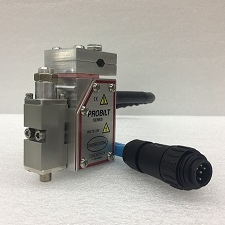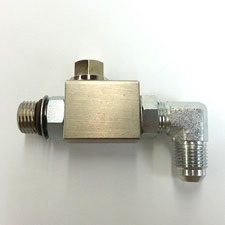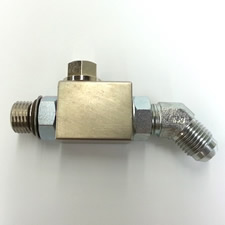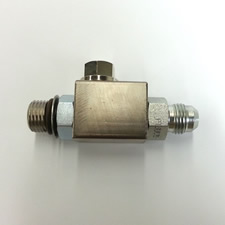When You Should Use a Pattern Controller
Pattern controllers come on the packaging lines themselves and not typically with a hot melt application system. But, while it is not something that many hot melt manufacturers make, it is very important to the glue application process.
Pattern controllers are used for specific glue applications and patterns. The latest pattern controllers have 4 channel controller capability to do both time and distance-based application programming. They can store up to 9 programs and have the capability of operating in “stitch mode” for substantial glue savings. Another unique feature is the low speed cutoff in distance mode to keep the glue off the side guides when the machine is slowed.
So, when do you need to use a pattern controller and which options do you need? Below are the definitions of both constant speed and variable speed controllers to help you figure out which option is best for your application process.
Constant Speed
Constant speed pattern controllers are also known as time-based controllers. The glue is dispensed consistently between .001 – 9.999 seconds, depending on the time that you set. They are designed to trigger a 24VDC Solenoid Valve and have on the fly program adjustments, so nothing is set in stone. Most constant speed pattern controllers have up to 4 programmable glue pattern events available and up to 9 programs can be stored in memory and remain in memory even after the system is shut down.
Variable Speed
Variable speed pattern controllers come with an encoder and are also known as distance-based. This means that the glue can be dispensed in set distances apart from the last application. Variable speed pattern controllers measure in tenths of inches, trigger a 24VDC Solenoid Valve and the encoder offers 1200 pulses per revolution. There is a low speed cut off and easy to use program adjustments. Like the constant speed controller, the variable speed controller has 4 programmable glue pattern events and 9 programs can be stored in memory and remain in memory even after the system is shut down.
There is also a hybrid version pattern controller that allows you to do both constant speed and variable speed.
To learn more about pattern controllers, their benefits and which one is right for you, please call (561) 272-5442 or reach out to a Sales Representative at sales@ussefl.com.
How to Obtain Maximum Adhesion on Your Packaging Line
As we return back to work from the shut down earlier this year, facilities may be experiencing several new situations or issues that they have either never dealt with before, or maybe they are new to the industry and need help with understanding how best to operate a high-speed packaging line. We are hearing from a lot of our customers, both old and new, that good adhesion has become a problem. Even though we are moving into the summer and the weather is no longer a potential cause of adhesion issues, there are a few other checklist items that you can walk through to help correct any lack of adhesion.
The first thing to check is the distance of your application gun and nozzle tip to the container or carton you are trying to glue together. If there is too much distance between the tip and the box, the glue could be cooling mid-air, not allowing the cartoner to get full adhesion when moving the box to the folding stage. This solution could be a simple mounting adjustment to lessen the space between the nozzle tip and the box.
Another item to review is the viscosity and melt rate of the glue you are using. It is imperative to educate your line operators on the glue specifications to make sure they are heating it to the correct temperature. On the flip side of that, make sure they are not over-heating it and making the glue too thin, creating a longer open time for the adhesive. Knowing the specifications of your glue will also help you to regulate the amount of glue you are using on your applications, hopefully keeping your operating budget down.
In addition to the above listed items, we also highly recommend regular maintenance on your hot melt system to limit the amount of char building up in the tank. Performing regular maintenance such as changing out tank filters, in-line filters and cleaning out the tank quarterly, will lessen the effects of char through the line. If you do have a lot of char build up, that can and will transfer through the system and onto the box. Too much char mixed in with your glue can be causing adhesion issues. Once the glue dries and hardens around the char, the char can separate from the box.
If you are experiencing any adhesion issues or have any other troubleshooting questions that you would like to review with a technician, please call Universal Systems SE at (561) 272-5442 or email tech@ussefl.com.
When Consumers Can’t Open their Boxes
Have you ever purchased a case of soda or carton of coffee cups and can’t get the box open? Of course, we all have. In the packaging industry, especially for hot melt machine manufacturers, that is a red flag. Whenever we get a box that has too much hot glue on it means that the packaging line is not set up properly or not being cleaned regularly.
If you are wondering why too much glue means that the line is not set up properly or not being cleaned regularly it is because one of two issues is occurring (or sometimes even both). The first issue is most likely that the line operators and/or maintenance managers are not cleaning the tank regularly and the lines are clogging up with char, which will subsequently clog nozzles. Instead of cleaning the tanks and hoses, and replacing the tank filter and in-line gun filters, most operations just buy bigger nozzles. If the diameter of the nozzle orifice is larger, then it will allow through more bits of char and not clog up as easily. Unfortunately, this is not a long-term solution. Putting down more hot glue will drive up the amount that facilities spend on adhesive pellets, and ultimately the annoyance will trickle down to the consumer when they can’t get their box open. The solution is simple…utilize Purge Plus to clean your tank every 1,000 hours. For some facilities that could mean cleaning every quarter and for others that could be twice a year, it all depends on the facility. In addition to cleaning the tank and hoses with Purge Plus, make sure that the tank filters are changed every 500 hours. The in-line gun filters should be changed every 150 hours to ensure that no char travels into the gun applicator, through the module and nozzle and onto the box.
The second issue that could cause too much glue on boxes, is that the line was not set up correctly from initial purchase. A lot of cartoners have standard hoses, guns, modules and nozzles that will work for most case packers, but not for all. Make sure to take into consideration the temperature of your packaging facility (which can impact the adhesion and viscosity of the glue as it travels through the application process), the distance that the guns are to the box upon application, and the surface area of the box you are covering. The longer the bead of glue you place, the less likely you are to need a larger diameter nozzle. The shorter the range you are covering, you might need more glue to make sure that maximum adhesion occurs, which means you need a larger diameter nozzle.
If you think you are putting down too much glue on your packaging line and need help, call one of Universal Systems’ technicians at (561) 272-5442. We have the most knowledgeable technicians in the business that can help you with almost any question.
RTD Sensors
RTD Sensors (resistance temperature detectors) are used in hot melt packaging systems because of their precision in sensing and proportioning temperature. They consistently maintain a temperature control stability of +/- 1-degree Fahrenheit. With the ever-increasing price of adhesive, it is important that RTD sensors are used in all of Universal Systems’ hot melt hoses and glue applicators for steady adhesive application. When combined with USSE’s patented AccuScan™ solid-state control system, RTD sensors provide precise bead uniformity for all of our ProBilt™ applicators.
Since RTD sensors are so key to the adhesive application process, it is important to check them first whenever you notice glue inconsistencies. If you see that your glue bead is not sticking properly or getting clogged, it could be caused by inconsistent glue temperature. There are several causes of inconsistent glue temperature. For example, if your tank operators are opening the cover to add glue, that will cause a temperature change. RTDs control that process, by notifying the heater to turn on and run longer when those situations occur. If your RTD is weak, then the heater will not be able to maintain steady temperature. It is the easiest, most overlooked and one of the least expensive components in your application process, but is worth it’s weight in glue!
When it comes to understanding the components that make up your adhesive application system, we believe that knowledge is power. So, if you have any questions, or think that you may be having issues with your RTD sensor, do not hesitate to call Universal Systems at (800) 848-5018 to speak with one of our technicians. We can walk your line operator through testing RTD sensors and how to switch them out correctly and safely.
The Importance of Using Aluminum for Manifolds
Universal Systems SE manufactures high quality hot melt application manifolds that will work with most all hot melt application systems. We understand the importance of durability, consistency and effectiveness in packaging manufacturing, which is why we use 6061T aluminum when making all of our manifolds.
What is a Manifold?
When evaluating what you need for your hot melt application system, it is important to understand each item that makes up the application gun. The manifold is the aluminum gun body, that houses the heater & sensor, and is where the modules mount.
Why do we use Aluminum?
Aluminum is used on all of our hot melt applicator manifolds because it is an excellent conductor of heat and dissipates heat very efficiently. Aluminum also has a very high strength to weight ratio, meaning that although it is light-weight, it is extremely strong. Its strength is what allows for peak performance during the rigorous packaging process. It is also non-toxic, cannot burn and is easily recyclable.
Why do we use 6061T Aluminum?
All of Universal System’s ProBilt™ manifolds are manufactured using 6061T aluminum. 6061T aluminum is aviation aluminum and used for the building of all jet aircrafts. This will extend the lifespan and durability of the manifold and increase it’s on the floor performance.
For more information on how to buy a hot melt gun applicator or manifold, please reach out to sales@ussefl.com or call (561) 272-5442 today!
The Importance of Utilizing Cross-Referencing
The packaging industry is entering the time of year when budgets are getting tight, but replacement parts are still needed. Universal Systems SE will cross-reference any of our competitor item numbers and get you high quality replacements. Cross-referencing Nordson item numbers to Universal Systems SE item numbers will help to lower your cost and keep your packaging lines running longer!
You will also notice that our competitors change their part number often. This is why we offer the search bar on our website for any cross-reference numbers you might have. Some of the most common cross references are listed below. If you purchase any of the parts listed on a regular basis, please feel free to call us today! We guarantee that all of our products are quality control tested before leaving our facility and we stand by all of our products with strong warranties.
Adhesive Systems:
P10, 1022234, 1022235, 276881, 276882, 276883, 276884, 276885, 276886, 276033, 276034, 238310, 243666, 168204, 166535 à ALL of these item numbers match USSE # D100-644
Heated Hoses:
4 Ft. Hose:
107288, 129556, 100120, 274791, 276151 –> 4104
6 Ft. Hose:
107286, 129557, 100121, 274792, 276152 –> 4106
8 Ft. Hose:
107287, 129559, 100122, 274793, 276153 –> 4108
10 Ft. Hose:
107289, 129561, 100123, 274794, 276154 –> 4110
12 Ft. Hose:
107310, 129562, 100124, 274795, 276155 –> 4112
16 Ft. Hose:
104008, 129564, 100125, 274796, 276156 –> 4116
20 Ft. Hose:
223838, 223836 –> 4120
24 Ft. Hose:
129565, 100832, 100126, 274797 –> 4124
Applicator Guns:
H200 1 Module AO/AC
8503717, 8505756, 8505768 –> 39105
H200 1 Module (AO/SC)
274596, 224939, 8503591, 8503686 –> 39107
Modules:
H200 (AO/AC)
1052927 –> 29215
H200 (AO/SC)
272282, 276119, 326583, 331979, 1048115, 2210, 2219, 2400, 2410 –> 29219
For any other questions on cross-referencing, please call (561) 272-5442 or email sales@ussefl.com.
In-Line Gun Filters
There are a couple different types of filters that you need to change out regularly on your adhesive melter system. One is a tank filter, which we describe in a previous article: The Importance of Tank Filters. The second, is the in-line gun filter. This is the filter that goes between the hot melt gun applicator and heated hose. This is the last line of defense against char being transferred through the module and potentially clogging the nozzle.
There are a three different in-line filter assemblies that are available for your hot melt system: Straight, 45 Degree & 90 Degree. The first is a filter assembly with a straight connector from the gun to the hose. This straight fitting is used when guns line up directly with hoses, typically applying the glue straight out to onto the boxes. The other two filter assemblies offer a 45 degree and 90 degree fitting that allows you to connect the hose to the gun at an angle. These filter assemblies are mostly used on setups where the applicator guns are either above or below the packaging line.
Each filter assembly is available with 50 mesh, 100 mesh and 200 mesh filters. The replacement filters are sold separately in packs of 5 for easy installation so that you do not need to switch out the entire assembly. The filter is easily screwed into the top of the filter body as seen below. Please make sure that you lubricate the o-rings before installation to help you for future filter changes.
For more information on which in-line filter assembly is best for you, please call (561) 272-5442 or email sales@ussefl.com.
Low Profile Glue Guns
Low profile guns are one of the most commonly used gun on cartoners. They come in two module and four module versions to allow for easy glue distribution on small to large box sizes. Their name comes from their unique gun body design which is angled on each side. The angled design sides allow for the box flaps to flawlessly close while the gun is applying the adhesive on to the boxes.
Even though the low profile guns look different than a standard gun applicator, they use standard H200 modules. This allows you to use the same modules and nozzles that you run on all of your other types of glue gun applicators. With both our two module and four module low profile gun, the modules are set with .88 inch centers and are a air-open, spring-close. The most commonly used nozzles for low profile guns are one or two orifice, right angle nozzles.
A few of our customers have asked over the years if Universal Systems SE manufactures a one module low profile gun. The answer would be no, however we can insert a custom module blank to the two module low profile gun, effectively turning it into a one module applicator. An advantage to this is that our custom module blank is removable, in case you ever change up your packaging line and need a two module low profile gun.
The item numbers for our Universal Systems SE ProBilt™ low profile gun heads are item # 3281 for the two module version and item # 3471 for the four module version. If you are interested in learning if your packaging line runs low profile guns compared to standard glue applicators, or the advantages to switching to a low profile gun, please call (561) 272-5442 or email sales@ussefl.com.
Custom Manifolds & Gun Applicators
There are not many manufacturers in the hot melt industry that have the ability to work with clients and create custom manifolds and gun applicators to fit their unique needs. Universal Systems SE has that ability and is willing to pair up our engineers with our client’s team to ensure that we manufacture the exact applicator needed for any job.
Over the last forty years, Universal Systems SE has manufactured an array of different custom manifolds and gun applicator systems for different types of industries. Not only can our custom gun manifolds distribute adhesive onto boxes in packaging lines, but they can be used for distributing make-up, candle gel, etc. Depending on the viscosity and melt rate of the substance needed to make the transfer, our custom manifolds and applicators will work with several different types of materials.
The custom manifold and gun process is simple. Contact one of Universal Systems SE’s customer service representatives, by either calling in to (561) 272-5442 or submitting a custom gun online form. You will then be connected with a USSE mechanical engineer. After all of the client’s needs are communicated with our engineering team and all questions answered, USSE will provide the customer with a custom manifold drawing for approval. The drawing will include dimensions of the manifold, spacing of modules, type of modules and all cordsets that are included and the location of those cordsets. Once the drawing is signed off on by the customer, we then manufacture the manifold body. After a vigorous quality control process, each custom manifold is inspected and tested to ensure all dimensions are correct and that the custom gun matches the approved drawing. Once the manifold passes all initial testing, modules are added and the custom gun is created and tested internally by two different QC Engineers. Once there is approval by both engineers, the final product is cleaned and ready for shipping.
The normal process for custom manufactured manifolds and completed guns is four to six weeks, with extra time potentially added in depending on customer turnaround time for drawing approvals.
If you are interested in learning more about the types of custom manifolds and gun applicators that Universal Systems SE can engineer for you, please call (561) 272-5442 or email sales@ussefl.com.
Water Wash Heated Hoses vs. High Flex Heated Hoses
Universal Systems SE manufactures our ClearFlow™ line of heated hoses. ClearFlow™ hoses can be used to transfer many different types of heated materials, however the most common is adhesive. There are two different types of heated hoses that USSE manufactures, high flex and water wash. Water wash, also known as washdown hoses, are manufactured with the same high-quality materials as our high flex hoses, but with a secure water wash connection between the hose and glue head. They are also encased with state of the art, high temperature, extremely durable, waterproof jacketing.
The main question that we get from customers is: why would we need a water-resistant hose? These are not hoses that get submerged under water. These water-resistant hoses, are used in facilities where machines are required to get washed down during or after operation. Hence the name water wash. For example, any type of food manufacturing plant such as ice cream, frozen food, cheese, etc. would be required by the FDA to wash down their equipment regularly. These wash downs impact all of the equipment in the facility, so if you are purchasing a water-resistant heated hose, you will also need a water-resistant gun applicator. The washdown gun applicator will also have the special waterproof jacketing on the cordset and water-resistant adaptor that fits with the hose. As displayed in the picture below.

All ClearFlow™ water wash hoses are manufactured with PTFE Teflon® inner cores and RTD temperature area-sensing. They have a maximum operating temperature of 450 degrees Fahrenheit, maximum operating pressure of 1,500 psi and are 240v. Universal Systems SE manufactures our washdown hoses in multiple lengths that range from 2 feet to 24 feet long.
If you are interested in getting pricing on a ClearFlow™ Water Wash heated hose, please call (561) 272-5442 or email sales@ussefl.com.





